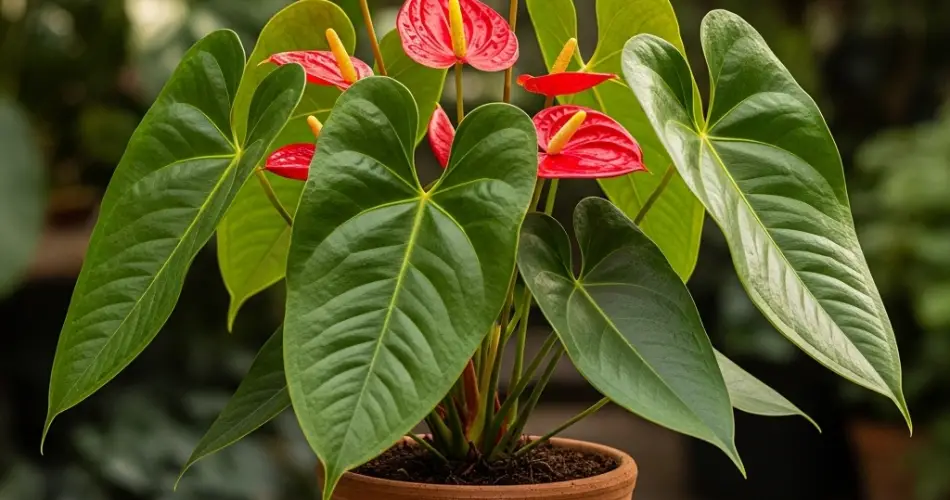Anthuriums are prized for their glossy, heart-shaped leaves and vibrant, long-lasting blooms that come in red, pink, white, and even purple shades. If you’re aiming to enjoy their spectacular flowering displays indoors, choosing the right pot is just as important as providing the right lighting and watering routine. The container not only affects the plant’s root health but also its ability to bloom consistently and thrive year-round.
Here’s a comprehensive guide on selecting the best indoor pots for your anthurium to ensure healthy growth and abundant flowers.
Why Pot Choice Matters for Anthuriums
Anthuriums originate from the tropical rainforests of Central and South America, where they grow as epiphytes or semi-epiphytes in well-drained environments. When grown in containers, replicating their natural conditions is essential. A well-chosen pot supports:
-
Proper drainage to prevent root rot
-
Adequate aeration for healthy root development
-
Moisture retention without waterlogging
-
Space for roots to grow without becoming cramped
Without these elements, your anthurium may produce fewer blooms, suffer from root issues, or become generally unhealthy.
Ideal Pot Size for Flowering Anthuriums
Size matters when it comes to pot selection. Anthuriums prefer being slightly root-bound. A pot that is too large holds excessive moisture, which can lead to soggy soil and hinder blooming. On the other hand, a pot that’s too small can restrict root expansion and stunt growth.
Best practice:
Choose a pot that is just 1 to 2 inches wider in diameter than the root ball of the plant. For most indoor anthuriums, a 6- to 8-inch pot is ideal. If your plant outgrows its container, repot into a slightly larger one during the growing season (spring or early summer).
Drainage Is Non-Negotiable
Drainage holes are essential. Anthuriums are highly sensitive to overwatering, and waterlogged soil can lead to root rot—a fast killer of tropical houseplants. Avoid decorative pots without holes unless you’re using them strictly as outer cachepots with a nursery pot inside.
If you love the look of a decorative pot without a drainage hole, here’s a simple solution:
-
Place your anthurium in a plastic nursery pot with holes.
-
Set it inside the decorative container.
-
After watering, remove excess water from the outer pot to avoid saturation.
Best Pot Materials for Anthurium Success
Each pot material has pros and cons. When choosing a pot for your anthurium, consider your watering habits and the environment of your home.
1. Terracotta or Clay Pots
These are porous and allow moisture to evaporate through the walls, reducing the risk of overwatering. They’re ideal for gardeners who tend to water frequently. However, they dry out more quickly and may require more frequent monitoring, especially in warmer indoor climates.
2. Plastic Pots
These retain moisture well and are lightweight. Plastic is great if you live in a dry environment or tend to forget to water. Just make sure the pot has enough drainage holes, and be cautious of moisture buildup.
3. Ceramic Pots (with Drainage)
These offer aesthetic appeal and better insulation for roots. Choose ceramic pots that include drainage holes or follow the cachepot method.
4. Self-Watering Pots
These can be useful if you’re often away or busy, but they should be used with care. Anthuriums prefer evenly moist—not soggy—soil. A self-watering pot with a wicking system and a well-aerated growing medium can be a good option for consistent hydration.
Choosing a Pot Shape
Anthuriums have a relatively upright growth habit, so a pot that’s deeper rather than excessively wide works best. This shape allows roots to grow downwards and supports tall flower stalks.
Avoid shallow pots, which don’t provide enough room for the root system and may tip over when the plant becomes top-heavy with blooms.
Complementing Pot Design with Home Decor
Anthuriums are not only botanical beauties—they’re also interior design accents. Choose pots that match or enhance your room’s style:
-
Sleek black or white ceramic pots for a modern look
-
Rustic terracotta for a natural, earthy feel
-
Glossy or textured planters to highlight the plant’s striking flowers
Whatever your style, keep practicality first—always prioritize proper drainage over aesthetics.
Bonus Tips for Better Blooming
Beyond pot choice, these tips will help your anthurium flower more regularly:
-
Use a chunky, well-draining soil mix with orchid bark, peat moss, and perlite.
-
Keep humidity between 60% and 80%, mimicking its natural habitat.
-
Provide bright, indirect light, avoiding harsh direct sun.
-
Feed with a phosphorus-rich fertilizer once a month during active growth to encourage more blooms.
-
Wipe leaves regularly to remove dust and help with efficient photosynthesis.
Final Thoughts
Choosing the right pot for your anthurium is a crucial step toward achieving consistent flowering success. Prioritize drainage, proper sizing, and breathable materials to give your plant the best environment to thrive. Whether you prefer minimalist ceramics or rustic terracotta, there’s a perfect pot that suits both your plant’s needs and your interior style.
With the right container and a little attentive care, your indoor anthurium will reward you with dazzling blooms and lush, green foliage all year long.



